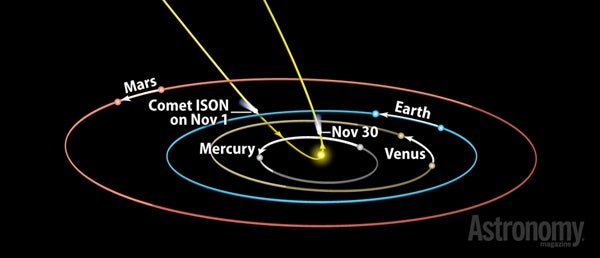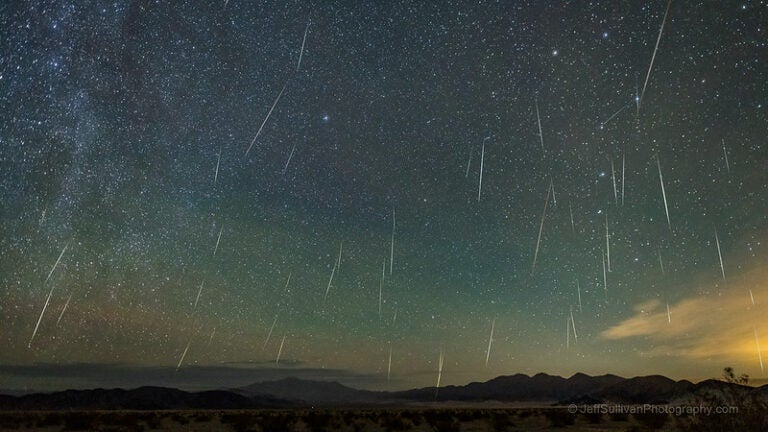We calculate six orbital “elements” from at least three observations spread out over days: the time and distance of the comet’s closest approach to the Sun (called perihelion), the eccentricity of the orbit (how stretched out it is), and three angles specifying the orbital plane of the comet with respect to Earth’s orbit. (The longer we see a comet, the better we can determine these elements.) Some comets pass extremely close to our star, while others have much farther-out perihelion distances.
We can predict how bright a comet will become with only some degree of certainty because it contains “volatile” ices that turn directly to gas as it approaches the Sun. Comets’ nuclei have varying amounts of ice and dust. How much of this material comes off during passages through the inner solar system varies tremendously among these objects and affects their brightnesses. A comet that passes closer to the Sun will lose more material and form a visible atmosphere (called a coma) and/or tail; more material increases the brightness.
Most comets follow our general predictions fairly well, but not all do. Sometimes the fragile cometary nucleus can break apart or display outbursts of material; many comets that go close to the Sun fragment, and some disappear altogether.
Thus, for Comet ISON (C/2012 S1), which has a long orbital period, we conservatively expect that the comet’s visual magnitude will brighten in relation to the comet’s distance from the Sun. When observers discovered this comet last year, it was near 6 astronomical units (an AU is basically the average Earth-Sun distance) from our star and Earth; by April 2013, it was still 4 AU away. Brightness measurements have been consistent thus far with our predictions, which suggests that it may brighten to magnitude –6 on November 28, 2013, when it will be only 0.012 AU from the Sun at perihelion. Comet ISON, however, will be only about 1° from the Sun as seen from Earth and thus exceedingly difficult (and dangerous) to view.
Two days before or after perihelion, when the comet is about 8° from the Sun, we expect its brightness to be closer to magnitude 0.5 (but still hard to see in bright twilight — when it’s just above a clear horizon and the Sun is just below the horizon). A couple days further removed from perihelion, the comet is likely to be around magnitude 2 and still only 13° to 15° from the Sun.
Comet ISON has an absolute magnitude of around 7, which is not particularly bright. For comparison, Comet Hale-Bopp (C/1995 O1) had an absolute magnitude of around –1.0.
Using recent observations with the Hubble Space Telescope, a team of astronomers deduced that the nucleus of Comet ISON is only around 1.2 miles (2 kilometers) in size or less. This suggests that the comet may not survive its passage so close to the Sun, and several scenarios could take place: It could produce a nice long tail that would be a splendid sight in the days before and after perihelion; it might break into large pieces that survive past perihelion, opening up more volatile ices in the inner original nucleus and thus surging in brightness; it could break apart with no nuclear pieces (or coma) visible after perihelion; or the comet might survive intact.
The Cometary Science Archive at Harvard University maintains a Web page for this comet at http://tinyurl.com/CSL2012S1, where scientists display detailed information, updates, observations, and photographs. You can also follow Astronomy’s comet coverage at www.Astronomy.com/ISON.
Daniel W. E. Green
Harvard University,
Cambridge, Massachusetts










